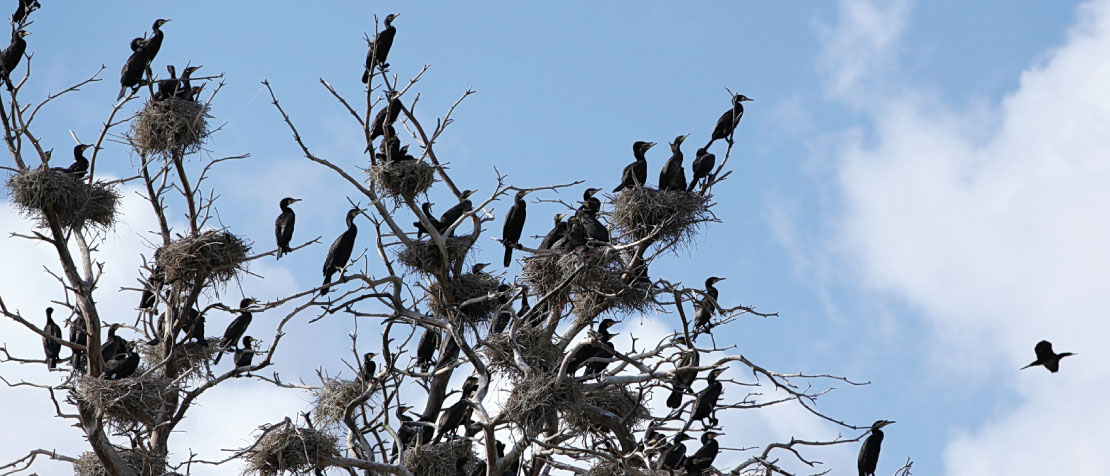New European plan aims to curb cormorant impacts on fisheries
Polish Presidency of the Council of the European Union hosted a Conference on Management Advice to Reduce Cormorant Predation Impacts.

©Piotr Traczuk
The population of great cormorants in Europe has increased in recent decades from some 50 000 birds in the 1970s to an estimated population of more than 2 million today. The success of this bird conservation by the European Union Birds Directive of EU Member States has had unintended consequences on the ecological balance of European waterways and on fisheries and aquaculture operations.
The Government of Poland and the Polish Presidency to the Council of Europe regard the sustainability of fisheries and aquaculture in European inland and coastal waters as crucial for food security and livelihoods. Given the increasing impact of cormorant predation of fish on the economic viability of aquaculture and inland commercial and recreational fisheries in Poland and elsewhere in Europe, the Polish Government decided to host a conference to bring this matter to the attention of European policy makers. The conference was attended by over 230 delegates from 35 countries who represented a wide spectrum of interests, including fisheries and environment policy and decision-makers, managers, representatives of bird-, fish-, and environmental conservation organizations, recreational fisheries and aquaculture organizations and many fish scientists, fishers and fish farmers.
Jacek Czerniak, Deputy Minister for Fisheries of Poland, mentioned that his government is “concerned about the impact of cormorants on the state of fish stocks, aquatic ecosystems and aquaculture” and emphasized the transboundary nature of this problem and the need for international coordination of the management of this species.
Raymon van Anrooy, Secretary of the European Inland Fisheries and Aquaculture Advisory Commission (EIFAAC) reported that, since 1990, freshwater aquaculture production in the 27 countries of the European Union has reduced by 19 percent and that many pond aquaculture farmers are suffering economically because of cormorant predation of their fish, for which often no financial compensation is available.
Felix Leinemann, representing the European Commission, welcomed the compilation of scientific evidence by EIFAAC. He said that “There are many measures that can be taken to limit the damage to economic activities. However, if these technical solutions fail and there is no other satisfactory solution, the Birds Directive allows derogations to kill cormorants under certain conditions. This can help Member States and fishers, anglers and other stakeholders to deal with the issue, in full respect of European Union legislation. Given the existing flexibility in the legal framework and toolbox of solutions, the Commission is not planning to change the legal protection regime of the cormorants or to endorse and implement a European cormorant management plan.”
At the heart of this conference was the proposal for a framework European management plan for the great cormorant, prepared by EIFAAC. Established under the umbrella of the Food and Agriculture Organization of the United Nations (FAO) in 1957, EIFAAC and has 38 members, including the European Commission. European-wide management of the migratory great cormorant has been requested by the European Parliament in 2008, 2018 and 2022 as well as by EIFAAC, given ongoing but unsuccessful national and local-level population control efforts . In line with its mandate, EIFAAC has been working with fisheries and aquaculture stakeholders as well as nature-, bird- and fish- conservation groups to develop a framework European management plan.
Ian Cowx of the University of Hull presented a draft framework for an adaptive plan which follows a process of scientific information gathering, analysis and advice, implementation, monitoring and evaluation and which is agreeable to all stakeholders. Data presented by Niels Jepsen of the Danish Technical University shows that the predation from great cormorant population growth and related increase in predation of fish “is now the main regulating factor for many freshwater fish stocks”. Members of EIFAAC will use contributions from discussions during the conference to finalize the plan and submit it to the European Parliament. The implementation of the plan will involve all key stakeholders, consistent with other wildlife management plans, such as those common for migratory birds and pelagic fish stocks.
Implementation of the plan, if approved, will ensure that the success of one species does not come at the cost of ecosystem balance, endangered fish species, the livelihoods of fishers and farmers, or Europe’s food security. The plan contributes to the implementation of the European Union Water Framework and Habitats Directives, the European Union Farm to Fork Strategy, European Union Biodiversity Strategy for 2030, and the European Union Nature Restoration Regulation.
Raschad Al-Khafaji, Director of the FAO Liaison Office with the European Union and Belgium, said that “The conservation and sustainable use of biodiversity and natural resources is complex. When policies have unintended consequences, they need to be adapted. European policy and law makers hold the key to ensure ecological balance and the resolution of conflicts.”
The conference participants discussed many aspects of the conflicts between cormorant – fish – fisheries and aquaculture interests and its impact. Topics included the massive increase of the cormorant population and related increase in conflicts; the reduced economic viability of aquaculture farms that encounter high levels of fish predation; an initiative by some Baltic Sea states to propose that the great cormorant is placed on Annex II Part B of the EU Bird Directive, which would allow hunting at national level; the negative impact of cormorants on the implementation of the European Union Water Framework Directive, under which many billions of euros are spent on restoration of waterways in Europe; and the need to establish a cormorant population size which corresponds with the situation in 1997, when the cormorant subspecies Phalacrocorax carbo sinensis, reached a favourable conservation status and was removed from Annex I of the European Union Birds Directive.

